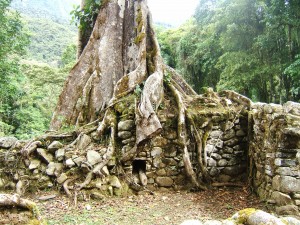
.
.
.
Ten years ago I sat in the middle of the ruins of Espíritu Pampa and despaired that it would ever be cleared. Dense jungle covered the site. Kapok trees had ripped open the Inca stonework, their roots gripping doorways and niches. Brush obscured the lines of the great Plaza, the kallankas and the ornamental fountains.
.
The work of ever restoring the place seemed both Herculean and pointless – the ruins were too extensive and remote, the vegetation just too dense, for this, unlike most Inca sites, had been built not in the mountains, but in the jungle on the eastern slopes of the Andes as they joined the Amazon.
.
The site has enormous emotional resonance – ‘the last bastion of Inca resistance’, as a noticeboard proclaims at its entrance, it saw the final dying of the flame after the Spanish conquest in 1532. Having held out in the mountains of the Vilcabamba for some 40 years, by 1572 the last Emperor, the young Tupac Amaru, was on the run, pursued down here into the rainforest by a Viceroy intent on finally wiping out “the pretender across the mountains”.
Espíritu Pampa was burnt in the process; the Emperor caught and executed.
But perhaps because it is such a potent symbol, the Peruvian government have made a superhuman effort and cleared it – one substantial section just three weeks before we arrived. I can finally appreciate the immense size of the site, radiating out from the central Plaza where they have tactfully left a few of the giant kapok trees.
Now is the time to visit, before the vegetation returns under a less benign or interested administration; or when someone realises that with just 30 or so visitors a year, the cost of maintaining it cannot be justified.
[NB Later note: since writing the above, I returned to Espíritu Pampa in 2015 with the explorer Benedict Allen to record some radio shows for the BBC and also write a Kindle Single book, Two Men and a Mule]
[and useful update in 2024 from Nick Jesson: ‘Road works mean potential closures or delays, particularly on the Santa María to Huancacalle road. They are developing the road to EP from New Vilcabamba along the Rio Pampaconas; this is big news and could be the shortest vehicular journey to EP. You can still hike this route and one local claimed to do it in 10 hours. I expect with these developments Huancacalle will become more of a tourist hub, and so it should with its proximity to so many amazing sites and trekking routes. Colectivos run from Santa María to Huancacalle. I saw one heading towards EP from Kiteni but with all colectivo routes I can’t help with their frequency or schedule.]

Sounds fascinating – how do we get there?
k
still a long journey, whether from the small village of Huancacalle (a good 3 days walk, but a wonderful one) or Quillabamba by road and another day’s walk. Hugh
I started reading The White Rock hoping it would aid me in visiting Espiritu Pampa (EP) without a multi-
day trek (more on that later) but as I read further I came to appreciate how well crafted the book is.
Towards the end, where you are revisiting sites you first visited 40 years earlier, you adroitly wove the
story of the last of the Incas with accounts of your earlier and present visits. A most enjoyable read.
The book would make an epic movie or series. Thank you.
I’m 80. One of my bucket-list entries is visiting EP. I’m not up to the 4- or more days trek,
particularly when I note that after the culmination of the trek, that is, from Espiritu Pamapa, the
visitor is guided on a one- to 4 hour hike to a waiting bus for transport back to Cusco. My question is,
why can’t I get to Espiritu Pampa by reversing the route of the trekkers? I have hovered over EP
(googlemaps) and its immediate vicinity, and I can see dirt roads winding up from road 28-B circa Rio
Apurimac to what looks like EP.
From another direction, in 2011 I made an attempt to get to EP from Kiteni via Chuanquiri and a further
village that may be named Concevidayoc. Unfortunately, the bridge over the local stream (Kiteni?) was
under construction so 4-wheel vehicles could not cross the stream. We walked towards EP until we had to
turn back to meet our ride.
I’d be grateful for any information you can share.
hi Allen – I’m just back from Espiritu Pampa so in good condition to advise on this – the roadhead only used to get to Azul Mayo, but now reaches Contabamba from Kiteni, which is just a few hours from Esp Pampa, so more easily accessible from Quillabamba in a single long day – I still prefer the traditional route, descending with mules from Huancacalle over the pass, a good 3-4 day trek – as have just done for the BBC for some radio shows -best wishes Hugh
Hi Hugh,
A few questions re Espiritu Pampa. Is there any public transport going from Quillabamba or Kiteni to Azulmayo-Contabamba or do you have to find a taxi or truck to make it to Contabamba?
Once arrived in Contabamba, do you need a local guide or is it easy to walk to the EP ruins on your own ? Any sleeping accommodation yet in EP ?
Have been trekking from Huancacalle to Espiritu Pampa (a wonderful walk indeed) long ago but, now in my seventies, I alas do not have the physical abilities anymore to repeat that experience. Would love the revisit the place though.
Thank you in anticipation for any info.
Sorry John I have not been there recently enough to be able to give you information about this – best of luck